


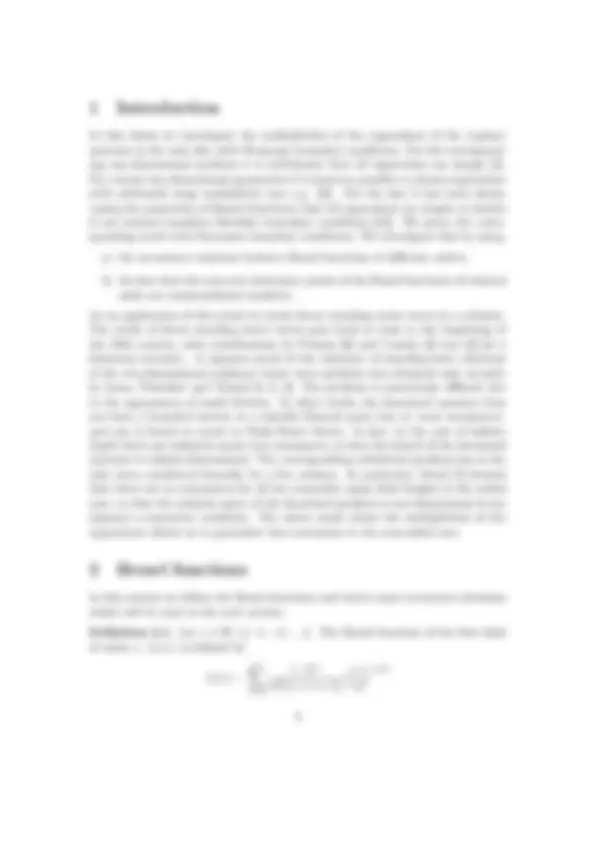
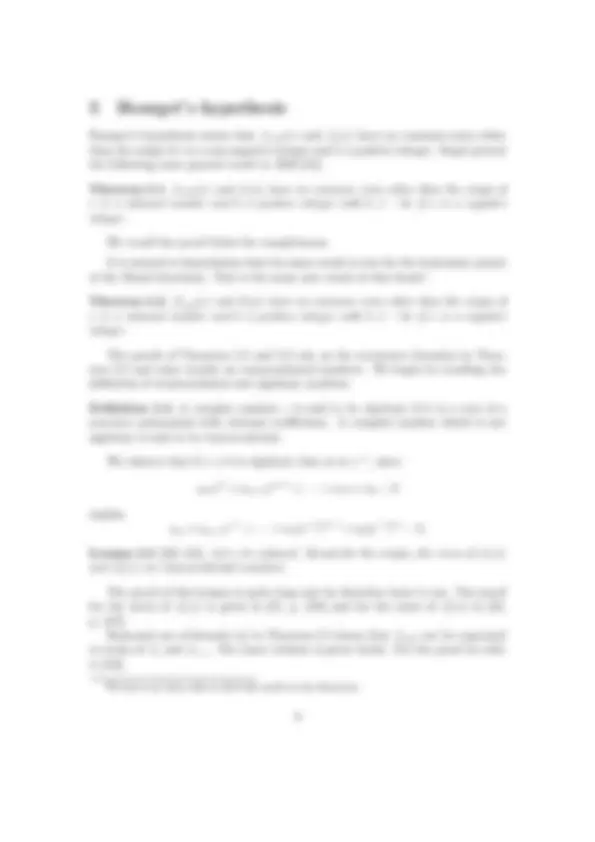
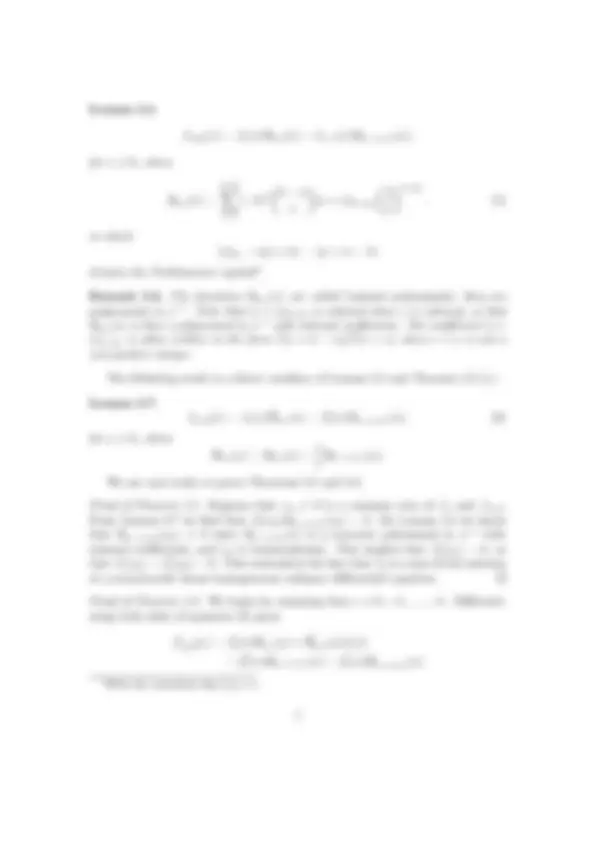
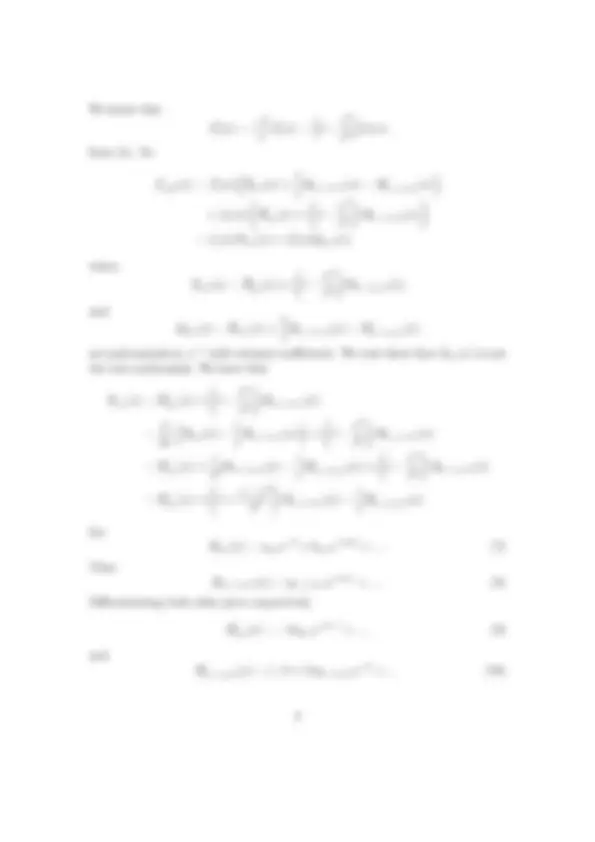
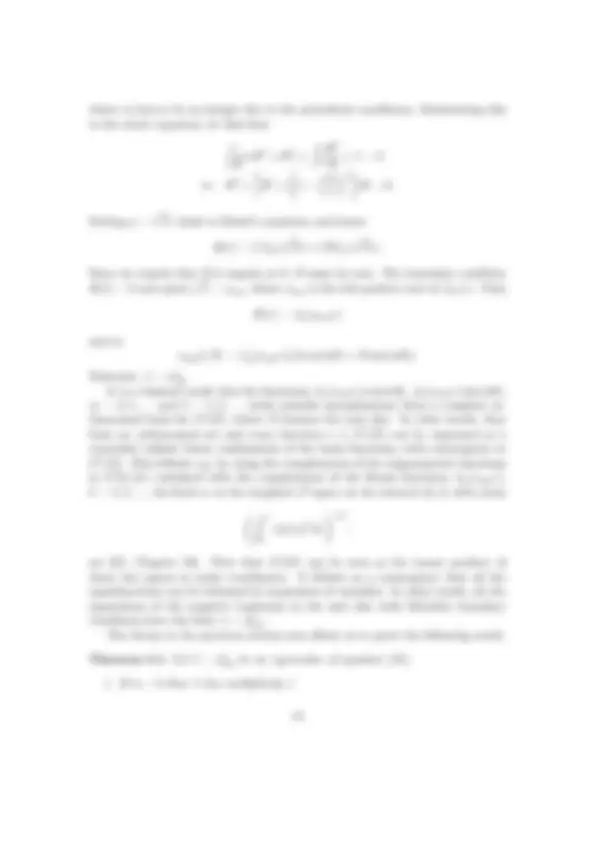
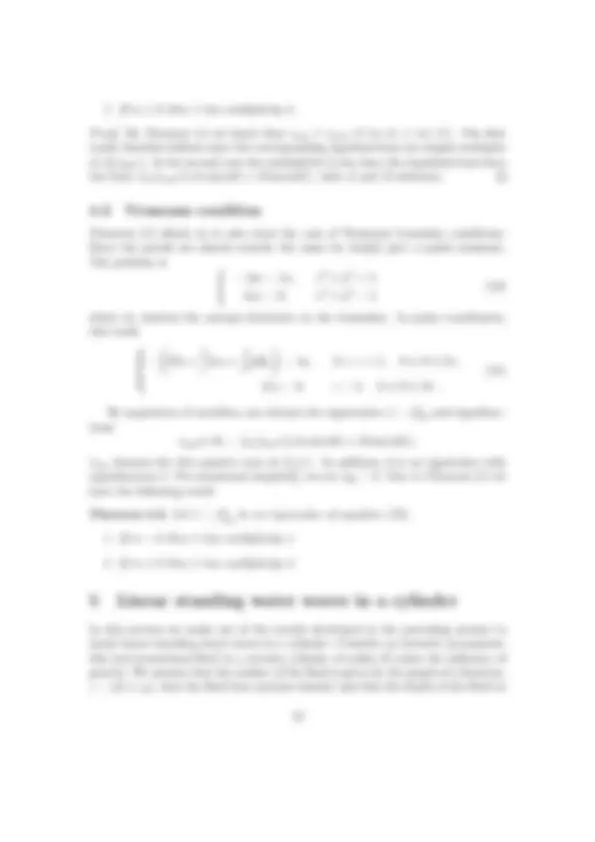
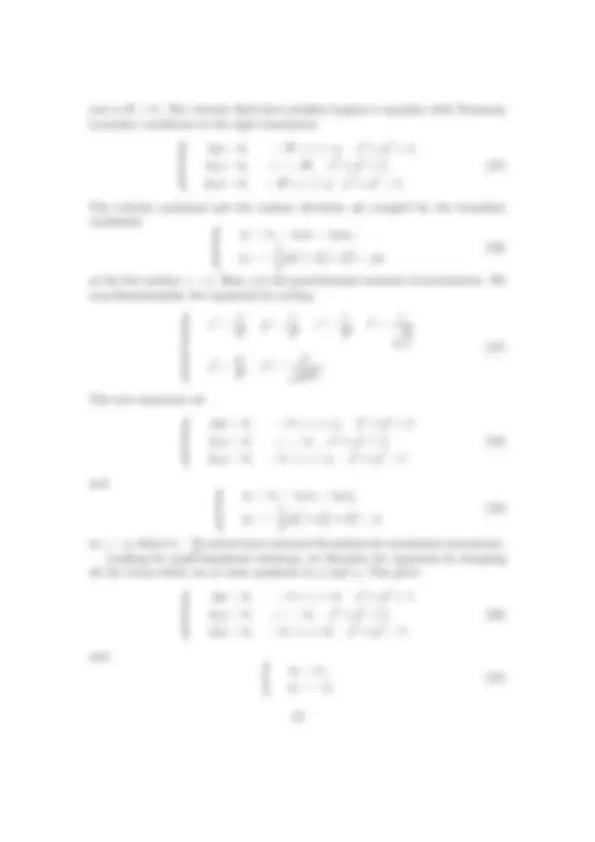
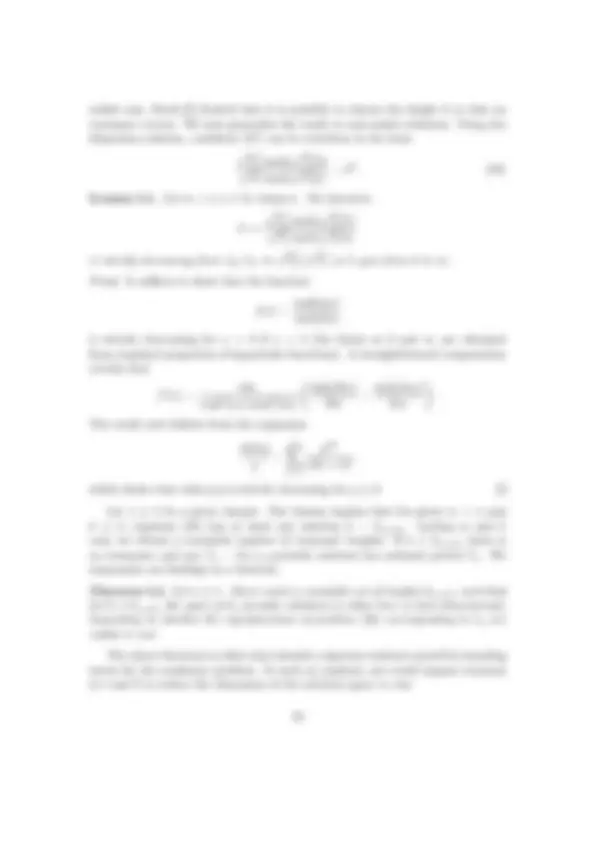
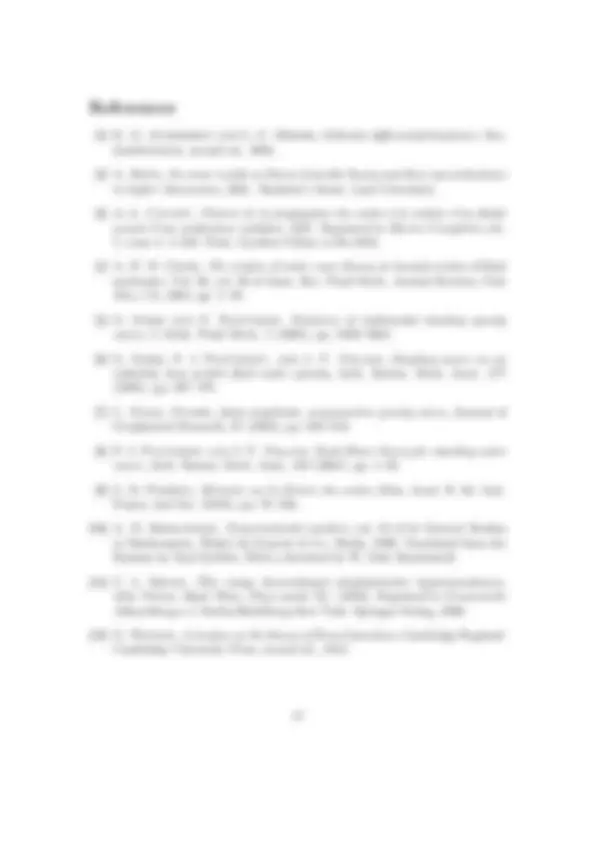




Study with the several resources on Docsity

Earn points by helping other students or get them with a premium plan


Prepare for your exams
Study with the several resources on Docsity

Earn points to download
Earn points by helping other students or get them with a premium plan
Community
Ask the community for help and clear up your study doubts
Discover the best universities in your country according to Docsity users
Free resources
Download our free guides on studying techniques, anxiety management strategies, and thesis advice from Docsity tutors
multiplicities of the eigenvalues of the Laplace operator in the unit disc with Neumann boundary conditions.
Typology: Summaries
1 / 21

This page cannot be seen from the preview
Don't miss anything!














Bachelor’s thesis 2013:K
Faculty of Science Centre for Mathematical Sciences Mathematics
1 Introduction
In this thesis we investigate the multiplicities of the eigenvalues of the Laplace operator in the unit disc with Neumann boundary conditions. For the correspond- ing one-dimensional problem it is well-known that all eigenvalues are simple [1]. For certain two-dimensional geometries it is however possible to obtain eigenvalues with arbitrarily large multiplicity (see e.g. [2]). For the disc it has been shown (using the properties of Bessel functions) that all eigenvalues are simple or double if one instead considers Dirichlet boundary conditions [12]. We prove the corre- sponding result with Neumann boundary conditions. We investigate this by using:
a) the recurrence relations between Bessel functions of different orders;
b) the fact that the non-zero stationary points of the Bessel functions of rational order are transcendental numbers.
As an application of this result we study linear standing water waves in a cylinder. The study of linear standing water waves goes back at least to the beginning of the 19th century, with contributions by Poisson [9] and Cauchy [3] (see [4] for a historical account). A rigorous proof of the existence of standing-wave solutions of the two-dimensional nonlinear water wave problem was obtained only recently by Iooss, Plotnikov and Toland [5, 6, 8]. The problem is notoriously difficult due to the appearance of small divisors. In other words, the linearised operator does not have a bounded inverse in a suitable Banach space due to ‘near resonances’, and one is forced to resort to Nash-Moser theory. In fact, in the case of infinite depth there are infinitely many true resonances, so that the kernel of the linearised operator is infinite-dimensional. The corresponding cylindrical problem has so far only been considered formally by a few authors. In particular, Mack [7] showed that there are no resonances for all but countably many fluid heights in the radial case, so that the solution space of the linearised problem is one-dimensional if one imposes a symmetry condition. The above result about the multiplicities of the eigenvalues allows us to generalise this conclusion to the non-radial case.
2 Bessel functions
In this section we define the Bessel functions and derive some recurrence formulae which will be used in the next section.
Definition 2.1. Let v ∈ R \ {− 1 , − 2 ,.. .}. The Bessel function of the first kind of order v, Jv(x), is defined by
Jv(x) =
n=
(−1)n n!Γ(v + n + 1)
(x
2
)v+2n
Differentiating both sides yields
d dx
(xvJv(x)) =
n=
2(v + n)(−1)nx^2 v+2n−^1 n!2v+2nΓ(v + n + 1)
n=
(−1)nx^2 v+2n−^1 n!2v+2n−^1 Γ(v + n)
n=
xv(−1)nx(v−1)+2n n!2(v−1)+2nΓ((v − 1) + n + 1) = xvJv− 1 (x).
Here we have used the fact that Γ(v + 1) = vΓ(v). Similarly,
d dx
(x−vJv(x)) = −x−vJv+1(x) (3)
when v is not a negative integer. If now v = −n is a negative integer, then
d dx
(xvJv(x)) = (−1)n^
d dx
(x−nJn(x)) = (−1)n+1x−nJn+1(x) = xvJv− 1 (x)
by (3), so that (2) still holds. In a similar way, one finds that (3) remains true if v is a negative integer. By expanding the left-hand side of (2), we get
xvJ v′(x) + vxv−^1 Jv(x) = xvJv− 1 (x).
Dividing both sides by xv−^1 yields
xJ v′(x) + vJv(x) = xJv− 1 (x) (4)
Hence we obtain (c). Similarly, expanding (3) gives
x−vJ v′(x) − vx−v−^1 Jv(x) = −x−vJv(x)
and multiplying by xv+1^ gives (d). Adding (c) and (d) gives
2 xJ v′(x) = xJv− 1 (x) − xJv+1(x)
which reduces to (b) after dividing by x. On the other hand, subtracting (d) from (c) gives 2 vJv(x) = xJv− 1 (x) + xJv+1(x)
which reduces to (a) after dividing by x.
3 Bourget’s hypothesis
Bourget’s hypothesis states that Jv+k(x) and Jv(x) have no common zeros other than the origin if v is a non-negative integer and k a positive integer. Siegel proved the following more general result in 1929 [11].
Theorem 3.1. Jv+k(x) and Jv(x) have no common zeros other than the origin if v is a rational number and k a positive integer with k 6 = − 2 v if v is a negative integer.
We recall the proof below for completeness. It is natural to hypothesise that the same result is true for the stationary points of the Bessel functions. This is the main new result of this thesis^1.
Theorem 3.2. J v′+k(x) and J v′(x) have no common zeros other than the origin if v is a rational number and k a positive integer with k 6 = − 2 v if v is a negative integer.
The proofs of Theorems 3.1 and 3.2 rely on the recurrence formulae in Theo- rem 2.2 and some results on transcendental numbers. We begin by recalling the definition of transcendental and algebraic numbers.
Definition 3.3. A complex number z is said to be algebraic if it is a root of a non-zero polynomial with rational coefficients. A complex number which is not algebraic is said to be transcendental.
We observe that if x 6 = 0 is algebraic then so is x−^1 , since
amxm^ + am− 1 xm−^1 + · · · + a 1 x + a 0 = 0
implies am + am− 1 x−^1 + · · · + a 1 (x−^1 )m−^1 + a 0 (x−^1 )m^ = 0.
Lemma 3.4 ([10, 11]). Let v be rational. Except for the origin, the zeros of Jv(x) and J v′(x) are transcendental numbers.
The proof of this lemma is quite long and we therefore leave it out. The proof for the zeros of Jv(x) is given in [11, p. 231] and for the zeros of J v′(x) in [10, p. 217]. Repeated use of formula (a) in Theorem 2.2 shows that Jv+k can be expressed in terms of Jv and Jv− 1. The exact relation is given below. For the proof we refer to [12].
(^1) We have not been able to find this result in the literature.
We know that
J v′′ (x) =
x
J v′(x) −
v^2 x^2
Jv(x)
from (1). So
J v′+k(x) = J v′(x)
R˜k,v(x) +^1 x
Rk− 1 ,v+1(x) − R k′− 1 ,v+1(x)
R^ ˜′ k,v(x) +
v^2 x^2
Rk− 1 ,v+1(x)
= Jv(x)Pk,v(x) + J v′(x)Qk,v(x),
where
Pk,v(x) = R˜′ k,v(x) +
v^2 x^2
Rk− 1 ,v+1(x)
and
Qk,v(x) = R˜k,v(x) +
x
Rk− 1 ,v+1(x) − R′ k− 1 ,v+1(x)
are polynomials in x−^1 with rational coefficients. We now show that Pk,v(x) is not the zero polynomial. We have that
Pk,v(x) = R˜ k,v′ (x) +
v^2 x^2
Rk− 1 ,v+1(x)
d dx
Rk,v(x) −
v x
Rk− 1 ,v+1(x)
v^2 x^2
Rk− 1 ,v+1(x)
= R k,v′ (x) +
v x^2
Rk− 1 ,v+1(x) −
v x
R′ k− 1 ,v+1(x) +
v^2 x^2
Rk− 1 ,v+1(x)
= R k,v′ (x) +
v − v^2 x^2
Rk− 1 ,v+1(x) −
v x
R′ k− 1 ,v+1(x).
Set Rk,v(x) = ak,vx−k^ + bk,vx−k+2^ +... (7)
Then Rk− 1 ,v+1(x) = ak− 1 ,v+1x−k+1^ +... (8)
Differentiating both sides gives respectively
R′ k,v(x) = −kak,vx−k−^1 +... (9)
and R′ k− 1 ,v+1(x) = (−k + 1)ak− 1 ,v+1x−k^ +... (10)
Thus
Pk,v(x) = (−kak,vx−k−^1 +.. .) +
v − v^2 x^2
(ak− 1 ,v+1x−k+1^ +.. .)
v x
((−k + 1)ak− 1 ,v+1x−k^ +.. .)
=
−kak,v + (v − v^2 )ak− 1 ,v+1 − v(−k + 1)ak− 1 ,v+
x−k−^1 +... = (−kak,v + (−v^2 + vk)ak− 1 ,v+1)x−k−^1 +...
From equation (5) we see that
ak,v = 2k(v)k.
We therefore obtain that
−kak,v + (−v^2 + vk)ak− 1 ,v+1 = −k 2 k(v)k + (−v^2 + vk)2k−^1 (v + 1)k− 1 = −k 2 · 2 k−^1 (v)k + (−v + k)2k−^1 (v)k = 2k−^1 (v)k(− 2 k + k − v) = − 2 k−^1 (v)k(v + k) = − 2 k−^1 (v)k+1,
showing that Pk,v(x) is not the zero polynomial if v 6 = 0, − 1 ,... , −k. We can now repeat the argument in the proof of Theorem 3.1. If x 0 6 = 0 is a common zero of J v′+k(x) and J v′(x), then Jv(x 0 )Pk,v(x 0 ) = 0. Since x 0 is transcendental, it follows that Jv(x 0 ) = J v′(x 0 ) = 0 and we have a contradiction. Finally, we handle the remaining cases v = 0, − 1 ,... , −k. The cases v = − 1 ,... , −k can be avoided by replacing Jv(x) by (−1)vJ|v|(x) and exchanging the roles of Jv(x) and Jv+k(x) if 2 |v| > k. This argument breaks down trivially if k is even and v = −k/ 2 , in which case Jv(x) = (−1)vJ|v|(x) = (−1)vJv+k(x). This leaves the case v = 0, for which the coefficient in front of the term x−^1 −k^ in Pk, 0 (x) vanishes. An explicit calculation shows that
Pk, 0 (x) = (2k−^1 (1)k− 1 + 2k−^2 (k − 2)(k − 1)(1)k− 2 )x^1 −k^ +... = 2k−^2 k!x^1 −k^ +... ,
when k ≥ 2 , and
P 1 , 0 (x) = 1.
In either case, it’s clear that Pk, 0 (x) doesn’t vanish identically. Hence we can use the same argument as above to prove that J k′(x) and J 0 ′(x) don’t have any common zeros except the origin.
where m has to be an integer due to the periodicity conditions. Substituting this in the above equation, we find that
1 rR
(rR′′^ + R′) +
r^2
r
λ −
(m r
Setting ρ =
λr leads to Bessel’s equation, and hence
R(r) = CJm(
λr) + DYm(
λr).
Since we require that R is regular at 0 , D must be zero. The boundary condition R(1) = 0 now gives
λ = αmk, where αmk is the kth positive root of Jm(r). Thus
R(r) = Jm(αmkr)
and so umk(r, θ) = Jm(αmkr)(A cos(mθ) + B sin(mθ)).
Moreover, λ = α^2 mk. It is a classical result that the functions Jm(αmkr) cos(mθ), Jm(αmkr) sin(mθ), m = 0, 1 ,... and k = 1, 2 ,... (with suitable normalisation) form a complete or- thonormal basis for L^2 (D), where D denotes the unit disc. In other words, they form an orthonormal set and every function u ∈ L^2 (D) can be expressed as a countably infinite linear combination of the basis functions, with convergence in L^2 (D). This follows e.g. by using the completeness of the trigonometric functions in L^2 (0, 2 π) combined with the completeness of the Bessel functions Jm(αmkr), k = 1, 2 ,.. ., for fixed m in the weighted L^2 -space on the interval (0, 1) with norm
(∫ (^1)
0
r|f (r)|^2 dr
see [12, Chapter 18]. Note that L^2 (D) can be seen as the tensor product of these two spaces in polar coordinates. It follows as a consequence that all the eigenfunctions can be obtained by separation of variables. In other words, all the eigenvalues of the negative Laplacian in the unit disc with Dirichlet boundary conditions have the form λ = α^2 mk. The theory in the previous section now allows us to prove the following result.
Theorem 4.1. Let λ = α^2 mk be an eigenvalue of equation (11).
Proof. By Theorem 3.1 we know that αmk 6 = αm′k′^ if (m, k) 6 = (m′, k′). The first result therefore follows since the corresponding eigenfunctions are simply multiples of J 0 (α 0 kr). In the second case the multiplicity is two since the eigenfunctions have the form Jm(αmkr)(A cos(mθ) + B sin(mθ)), with A and B arbitrary.
Theorem 3.2 allows us to also treat the case of Neumann boundary conditions. Since the proofs are almost exactly the same we simply give a quick summary. The problem is (^) { −∆u = λu, x^2 + y^2 < 1 , ∂nu = 0, x^2 + y^2 = 1,
where ∂n denotes the normal derivative at the boundary. In polar coordinates, this reads
∂^2 r u +
r
∂ru +
r^2
∂ θ^2 u
= λu, 0 < r < 1 , 0 6 θ 6 2 π,
∂ru = 0, r = 1, 0 6 θ 6 2 π.
By separation of variables, one obtains the eigenvalues λ = β mk^2 and eigenfunc- tions umk(r, θ) = Jm(βmkr)(A cos(mθ) + B sin(mθ)).
βmk denotes the kth positive root of J m′(r). In addition, 0 is an eigenvalue with eigenfunction 1. For notational simplicity, we set β 00 = 0. Due to Theorem 3.2 we have the following result.
Theorem 4.2. Let λ = β^2 mk be an eigenvalue of equation (13).
5 Linear standing water waves in a cylinder
In this section we make use of the results developed in the preceding section to study linear standing water waves in a cylinder. Consider an inviscid, incompress- ible and irrotational fluid in a circular cylinder of radius R under the influence of gravity. We assume that the surface of the fluid is given by the graph of a function, z = η(t, x, y), that the fluid has constant density and that the depth of the fluid at
at z = 0. We separate variables by setting
φ = f (x, y)g(z)u(t).
This implies
(∆f )gu + f g′′u = 0, −h < z < 0 , x^2 + y^2 < 1 ,
which reduces to ∆f f
−g′′ g
= −λ.
Thus
{ −∆f = λf, x^2 + y^2 < 1 , ∂nf = 0, x^2 + y^2 = 1
and (^) { g′′^ = λg, g′(−h) = 0.
Equation (22) represents the Neumann eigenvalue problem for −∆ in the unit disc. According to previous results each eigenvalue has multiplicity at most 2. Equation (23) gives g(z) = A cosh(
λ(z + h)),
so φ(t, x, y, z) = fn(x, y) cosh(
λn(z + h))u(t),
where fn is an eigenfunction corresponding to λn. Substitution in equation (21) gives ηt(t, x, y) = fn(x, y)
λn sinh(
λnh)u(t) (24)
and fn(x, y) cosh(
λnh)u′(t) = −η(t, x, y). (25)
Substitution of equation (25) in equation (24) gives
−fn(x, y) cosh(
λn(z))u′′(t) =
λnfn(x, y) sinh(
λnh)u(t),
which implies
−u′′(t) =
λn sinh(
λnh) cosh(
λnh)
u(t).
This equation has the solution
u(t) = A cos(ωnt) + B sin(ωnt)
where ω^2 n =
λn tanh(
λnh). (26)
Hence
φ(t, x, y, z) = fn(x, y) cosh(
λn(z + h))(A cos(ωnt) + B sin(ωnt))
and η(t, x, y, z) = ωnfn(x, y) cosh(
λnh)(A sin(ωnt) − B cos(ωnt)).
This represents a standing wave; it is time-periodic with minimal period
Tn =
2 π ωn
Equation (26), which gives the permissible values of the angular velocity ω, is called the dispersion relation. When studying the corresponding nonlinear problem, it is of great importance to know the dimension of the space of time-periodic solutions for a fixed period T = (^2) ωπ. If we just consider solutions of minimal period T = Tn, then the answer can be obtained using the results in the previous section. If the corresponding eigenvalue λn is simple,
φ = fn(x, y) cosh(
λn(z + h))A cos(ωnt) + B sin(ωnt)
and ηn(t, x, y, z) = fn(x, y) cosh(
λnh)(A sin(ωnt) − B cos(ωnt))
where for each solution, fn = CJ 0 (β 0 kr).
for some C, and λn = β^20 k.
We thus get a two-dimensional space of solutions. On the other hand, if λn is double, we wll get a four-dimensional space of solutions since
fn = Jj (βjkr)(C cos(jθ) + D sin(jθ)),
for some j ≥ 1 Note however that a solution of minimal period Tm is also periodic of period kTm for any integer k ≥ 2. This means that if
ωm = kωn, (27)
k ≥ 2 integer, then (ηm, φm) and (ηn, φn) are both periodic with period Tn = 2 π/ωn. This kind of resonance complicates the nonlinear analysis [5, 6]. In the
References
[1] K. G. Andersson and L.-C. Böiers, Ordinära differentialekvationer, Stu- dentlitteratur, second ed., 1992.
[2] A. Beck, On some results in Sturm-Liouville theory and their generalizations to higher dimensions, 2011. Bachelor’s thesis. Lund University.
[3] A.-L. Cauchy, Théorie de la propagation des ondes à la surface d’un fluide pesant d’une profondeur indéfinie, 1827. Reprinted in Œuvres Complètes, sér. 1, tome 1, 5–318, Paris, Gauther-Villars et fils,1882.
[4] A. D. D. Craik, The origins of water wave theory, in Annual review of fluid mechanics. Vol. 36, vol. 36 of Annu. Rev. Fluid Mech., Annual Reviews, Palo Alto, CA, 2004, pp. 1–28.
[5] G. Iooss and P. Plotnikov, Existence of multimodal standing gravity waves, J. Math. Fluid Mech., 7 (2005), pp. S349–S364.
[6] G. Iooss, P. I. Plotnikov, and J. F. Toland, Standing waves on an infinitely deep perfect fluid under gravity, Arch. Ration. Mech. Anal., 177 (2005), pp. 367–478.
[7] L. Mack, Periodic, finite-amplitude, axisymmetric gravity waves, Journal of Geophysical Research, 67 (1962), pp. 829–843.
[8] P. I. Plotnikov and J. F. Toland, Nash-Moser theory for standing water waves, Arch. Ration. Mech. Anal., 159 (2001), pp. 1–83.
[9] S. D. Poisson, Mémoire sur la théorie des ondes, Mém. Acad. R. Sci. Inst. France, 2nd Ser. (1816), pp. 70–186.
[10] A. B. Shidlovskii, Transcendental numbers, vol. 12 of de Gruyter Studies in Mathematics, Walter de Gruyter & Co., Berlin, 1989. Translated from the Russian by Neal Koblitz, With a foreword by W. Dale Brownawell.
[11] C. L. Siegel, Über einige Anwendungen diophantischer Approximationen, Abh. Preuss. Akad. Wiss., Phys.-math. Kl., (1929). Reprinted in Gesammelte Abhandlungen I, Berlin-Heidelberg-New York: Springer-Verlag, 1966.
[12] G. Watson, A treatise on the theory of Bessel functions, Cambridge England: Cambridge University Press, second ed., 1944.